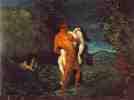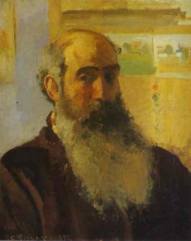PAUL CEZANNE: EARLY ROMANTIC PERIOD
His early years were difficult and his career was, from the beginning,
dogged with repeated failure and rejection. In 1862 he was introduced to
the famed circle of artists who met at the Café Guerbois in Paris,
which included Manet, Degas and Pissarro, but his awkward manners and defensive
shyness prevented him from becoming an intimate of the group. However, Pissarro
was to play an important part in Cézanne's later development.
PISSARO
Abduction,
rape, and murder are themes that tormented Cézanne during his early period.
Abduction (c. 1867, 90 x 117 cm (35 x 46 in)), an early work full of dark miseries,
is impressive largely for its turgid force, held barely under his control. These
figure paintings are the most difficult to enter into; they are sinister, with
passion in turmoil just beneath the surface.

One
of the most important works of his early years is the portrait of his formidable
father. The Artist's Father (1866, 199 x 119 cm (78 x 47 in)) is one of Cézanne's
``palette-knife pictures'', painted in short sessions between 1865 and 1866.
Their realistic content and solid style reveal Cézanne's admiration for
Gustave Courbet. Here we see a craggy, unyielding man of business, a solid mass
of manhood, bodily succint from the top of his black beret to the tips of his
heavy shoes. The uncompromising verticals of the massive chair are echoed by
the door, and the edges of the small
Cézanne was in his twenties when he painted The Artist's Father. Wonderful
though it is, with its blacks and greys and umbers, it does not fully indicate
the profundity of his developing genius. Yet even in this early work, Cézanne's
grasp of form and solid pictorial structures which came to dominate his mature
style are already essential components. His overriding concern with form and
structure set him apart from the Impressionists from the start, and he was to
maintain this solitary position, carving out his unique pictorial language.
Portrait of the Artist's Father

